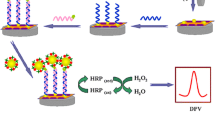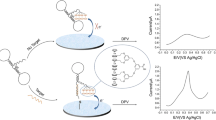Abstract
A selective DNA sensing with zeptomole detection level is developed based on coulometric measurement of gold nanoparticle (AuNPs)-mediated electron transfer (ET) across a self-assembled monolayer on the gold electrode. After immobilization of a thiolated hairpin-structured DNA probe, an alkanethiol monolayer was self-assembled on the resultant electrode to block [Fe(CN)6]3−/4− in a solution from accessing the electrode. In the presence of DNA target, hybridization between the DNA probe and the DNA target breaks the stem duplex of DNA probe. Consequently, stem moiety at the 3′-end of the DNA probes was removed from the electrode surface and made available for hybridization with the reporter DNA-AuNPs conjugates (reporter DNA-AuNPs). The thiolated reporter DNA matches the stem moiety at the 3′-end of the DNA probe. AuNPs were then enlarged by immersing the electrode in a growth solution containing HAuCl4 and H2O2 after the reporter DNA-AuNPs bound onto the electrode surface. The enlarged AuNPs on the electrode restored the ET between the electrode and the [Fe(CN)6]3−/4−, as a result, amplified signals were achieved for DNA target detection using the coulometric measurement of Fe(CN)6 3− electro-reduction by prolonging the electrolysis time. The quantities of ET on the DNA sensor increased with the increase in DNA target concentration through a linear range of 3.0 fM to 1.0 pM when electrolysis time was set to 300 s, and the detection limit was 1.0 fM. Correspondingly, thousands of DNA (zeptomole) copies were detected in 10-μL samples. Furthermore, the DNA sensor showed excellent differentiation ability for single-base mismatch.
Similar content being viewed by others
References
Sassolas A, Leca-Bouvier BD, Blum LJ. DNA biosensors and microarrays. Chem Rev, 2008, 108: 109–139
Paleček E, Bartošík M. Electrochemistry of nucleic acids. Chem Rev, 2012, 112: 3427–3481
Kimmel DW, LeBlanc G, Meschievitz ME, Cliffel DE. Electrochemical sensors and biosensors. Anal Chem, 2012, 84: 685–707
Zhang YC, Pothukuchy A, Shin W, Kim Y, Heller A. Detection of ∼103 copies of DNA by an electrochemical enzyme-amplified sandwich assay with ambient O2 as the substrate. Anal Chem, 2004, 76: 4093–4097
Sin MLY, Liu TT, Pyne JD, Gau V, Liao JC, Wong PK. In situ electrokinetic enhancement for self-assembled-monolayer-based electrochemical biosensing. Anal Chem, 2012, 84: 2702–2707
Zhang J, Song SP, Zhang LY, Wang LH, Wu HP, Pan D, Fan CH. Sequence-specific detection of femtomolar DNA via a chronocoulometric DNA sensor (CDS): Effects of nanoparticle-mediated amplification and nanoscale control of DNA assembly at electrodes. J Am Chem Soc, 2006, 128: 8575–8580
Xuan F, Luo X, Hsing I. Ultrasensitive solution-phase electrochemical molecular beacon-based DNA detection with signal amplification by exonuclease III-assisted target recycling. Anal Chem, 2012, 84: 5216–5220
Ji H, Yan F, Lei J, Ju H. Ultrasensitive electrochemical detection of nucleic acids by template enhanced hybridization followed with rolling circle amplification. Anal Chem, 2012, 84: 7166–7171
Dong H, Zhu Z, Ju H, Yan F, Triplex signal amplification for electrochemical DNA biosensing by coupling probe-gold nanoparticles-graphene modified electrode with enzyme functionalized carbon sphere as tracer. Biosens Bioelectron, 2012, 33: 228–232
Saha K, Agasti SS, Kim C, Li XN, Rotello VM. Gold nanoparticles in chemical and biological sensing. Chem Rev, 2012, 112: 2739–2779
McAuley CB, Dickinson EJF, Rees NV, Toghill KE, Compton RG. New electrochemical methods. Anal Chem, 2012, 84: 669–684
Garcıa T, Casero E, Parra MR, Pariente F, Lorenzo E. Dual-stage DNA sensing: recognition and detectio. Anal Chem, 2008, 80: 9443–9449
Zhou X, Xia SJ, Lu ZQ, Tian Y. Yan YS, Zhu J. Biomineralization-assisted ultrasensitive detection of DNA. J Am Chem Soc, 2010, 132: 6932–6934
Polsky R, Gill R, Kaganovsky L, Willner I. Nucleic acid-functionalized Pt nanoparticles: catalytic labels for the amplified electrochemical detection of biomolecules. Anal Chem, 2006, 78: 2268–2271
Selvaraju T, Das J, Jo K, Kwon K, Huh CH, Kim TK, Yang H. Nanocatalyst-based assay using DNA-conjugated Au nanoparticles for electrochemical DNA detection. Langmuir, 2008, 24: 9883–9888
Kwon SJ, Bard AJ. DNA analysis by application of Pt nanoparticle electrochemical amplification with single label response. J Am Chem Soc, 2012, 134: 10777–10779
Katayama Y, Ohuchi Y, Hideyoshi H, Yoshihisa K, Mizuo M. The design of cyclic AMP-recognizing oligopeptides and evaluation of its capability for cyclic AMP recognition using an electrochemical system. Anal Chem, 2000, 72: 4671–4674
Aoki H, Umezawa Y. Trace analysis of an oligonucleotide with a specific sequence using PNA-based ion-channel sensors. Analyst, 2003, 128: 681–685
Das J, Cederquist KB, Zaragoza AA, Lee PE, Sargent EH, Kelley SO. An ultrasensitive universal detector based on neutralizer displacement. Nat Chem, 2012, 4: 642–648
Li HL, Li D, Liu JY, Qin YN, Ren JT, Xu S L, Liu YQ, Mayer D, Wang EK. Electrochemical current rectifier as a highly sensitive and selective cytosensor for cancer cell detection. Chem Commun, 2012, 48: 2594–2596
Liu YQ, Offenhäussera A, Mayer D. Rectified tunneling current response of bio-functionalized metal-bridge-metal junctions. Biosens Bioelectron, 2010, 25: 1173–1178
Abruiia HD, Denisevich P, Umaiia M, Meyer TJ, Murray RW. Rectifying interfaces using two-layer films of electrochemically polymerized vinylpyridine and vinylbipyridine complexes of ruthenium and iron on electrodes. J Am Chem Soc, 1981, 103: 1–5
Alleman KS, Weber K, Creager SE. Electrochemical rectification at a monolayer-modified electrode. J Phys Chem, 1996, 100: 17050–17058
Kissling GP, Bunzli C, Fermın DJ. Tuning electrochemical rectification via quantum dot assemblies. J Am Chem Soc, 2010, 132: 16855–16861
Liu YQ, Offenhausser A, Mayer D. An electrochemically transduced XOR logic gate at the molecular level. Angew Chem Int Ed, 2010, 122: 2649–2652
Yoshio U, Hiroshi A. A number of ion channel sensors have been developed based on various artificial receptors for inorganic and organic ions and bioactive substances. Anal Chem, 2004, 321A–326A
Oh SK, Baker LA, Crooks RM. Electrochemical rectification using mixed monolayers of redox-active ferrocenyl dendrimers and n-alkanethiols. Langmuir, 2002, 18: 6981–6987
Shein JB, Lai L MH, Eggers PK, Paddon-Row MN, Gooding JJ. Formation of efficient electron transfer pathways by adsorbing gold nanoparticles to self-assembled monolayer modified electrodes. Langmuir, 2009, 25: 11121–11128
Zhao JJ, Bradbury CR, Fermın DJ. Long-range electronic communication between metal nanoparticles and electrode surfaces separated by polyelectrolyte multilayer films. J Phys Chem C, 2008, 112: 6832–6841
Noel Chazalviel J, Allongue P. On the origin of the efficient nanoparticle mediated electron transfer across a self-assembled monolayer. J Am Chem Soc, 2011, 133: 762–764
Weizmann Y, Patolsky F, Popov I, Willner I. Telomerase-generated templates for the growing of metal nanowires. Nano Lett, 2004, 4: 787–792
Du H, Strohsahl CM, Camera J, Miller BL, Krauss TD. Sensitivity and specificity of metal surface-immobilized “molecular beacon” biosensors. J Am Chem Soc, 2005, 127: 7932–7940
Grabar KC, Freeman RG, Hommer MB, Natan MJ. Preparation and characterization of Au colloid monolayers. Anal Chem, 1995, 67: 735–743
Demers LM, Mirkin CA, Mucic RC, Reynolds RA, Letsinger RL, Elghanian R, Viswanadham G. A fluorescence-based method for determining the surface coverage and hybridization efficiency of thiolcapped oligonucleotides bound to gold thin films and nanoparticles. Anal Chem, 2000, 72: 5535–5541
Das J, Jo K, Lee JW, Yang H. Electrochemical immunosensor using p-aminophenol redox cycling by hydrazine combined with a low background current, Anal Chem, 2007, 79: 2790–2796
Gao Q, Zhang WY, Guo YY, Qi HL, Zhang CX. Highly sensitive impedimetric sensing of DNA hybridization based on the target DNA-induced displacement of gold nanoparticles attached to ssDNA probe. Electrochem Commun, 2011, 13: 335–337
Engelkes VB, Beebe JM, Frisbie CD. Length-dependent transport in molecular junctions based on SAMs of alkanethiols and alkanedithiols: effect of metal work function and applied bias on tunneling efficiency and contact resistance. J Am Chem Soc, 2004, 126: 14287–14296
Shein JB, Lai L MH, Eggers PK, Paddon-Row MN, Gooding JJ. Formation of efficient electron transfer pathways by adsorbing gold nanoparticles to self-assembled monolayer modified electrodes. Langmuir, 2009, 25: 11121–11128
Dai H, Meyer M, Stepaniants S, Ziman M, Stoughton R. Use of hybridization kinetics for differentiating specific from non-specific binding to oligonucleotide microarrays. Nucleic Acids Res, 2002, 30: e86
Mirkin CA, Letsinger RL, Mucic RC, Storhoff JJ. A DNA-based method for rationally assembling nanoparticles into macroscopic materials. Nature, 1996, 382: 607–609
Nam JM, Park SJ, Mirkin CA. Bio-barcodes based on oligonucleotide-modified nanoparticles. J Am Chem Soc, 2002, 124: 3820–3821
Das J, Yang H. Enhancement of electrocatalytic activity of DNA-conjugated gold nanoparticles and its application to DNA detection. J Phys Chem C, 2009, 113: 6093–6099
Lubin AA, Plaxco KWA. Folding-based electrochemical biosensors: The case for responsive nucleic acid architectures. Chem Res, 2010, 43: 496–505
Blum AS, Ren T, Parish DA, Trammell SA, Moore MH, Kushmerick JG, Xu GL, Deschamps JR, Pollack SK, Shashidhar R. Ru2(ap)4(σ-oligo(phenyleneethynyl)) molecular wires: synthesis and electronic characterization. J Am Chem Soc, 2005, 127: 10010–10011
Zayats M, Baron R, Popov I, Willner I. Biocatalytic growth of Au nanoparticles: from mechanistic aspects to biosensors design. Nano Lett, 2005, 5: 21–25
Alhasan AH, Kim DY, Daniel WL, Watson E, Meeks JJ, Thaxton CS, Mirkin CA. Scanometric microRNA array profiling of prostate cancer markers using spherical nucleic acid-gold nanoparticle conjugates. Nanoparticle Conjugates, 2012, 84: 4153–4160
Das J, Aziz MA, Yang H. A nanocatalyst-based assay for proteins: DNA-free ultrasensitive electrochemical detection using catalytic reduction of p-nitrophenol by gold-nanoparticle labels. J Am Chem Soc, 2006, 128: 16022–16023
Steel AB, Herne TM, Tarlov MJ. Electrochemical quantitation of DNA immobilized on gold. Anal Chem, 1998, 70, 4670–4677
Liu J, Yuan XQ, Gao Q, Qi HL, Zhang CX. Ultrasensitive DNA detection based on coulometric measurement of enzymatic silver deposition on gold nanoparticle-modified screen-printed carbon electrode. Sens Actuators B, 2012, 162: 384–390
Lai GS, Yan F, Wu J, Leng C, Ju HX. Ultrasensitive multiplexed immunoassay with electrochemical stripping analysis of silver nanoparticles catalytically deposited by gold nanoparticles and enzymatic reaction. Anal Chem, 2011, 83: 2726–2732
Author information
Authors and Affiliations
Corresponding author
Electronic supplementary material
Rights and permissions
About this article
Cite this article
Wang, W., Yuan, X., Liu, X. et al. Selective DNA detection at Zeptomole level based on coulometric measurement of gold nanoparticle-mediated electron transfer across a self-assembled monolayer. Sci. China Chem. 56, 1009–1016 (2013). https://doi.org/10.1007/s11426-013-4860-6
Received:
Accepted:
Published:
Issue Date:
DOI: https://doi.org/10.1007/s11426-013-4860-6




